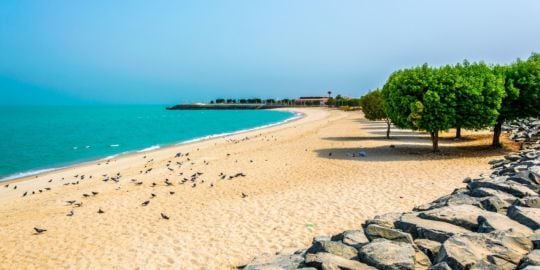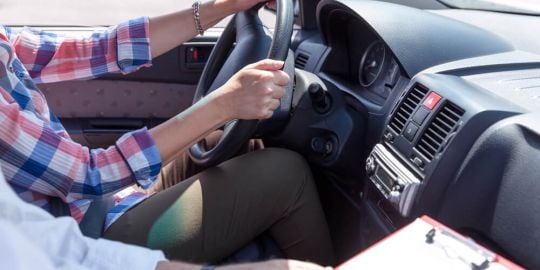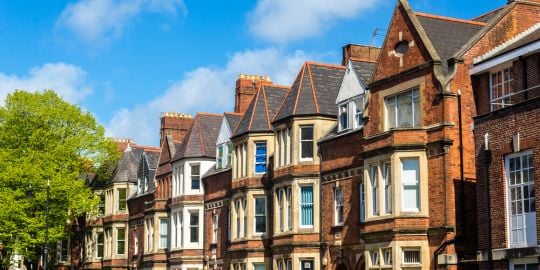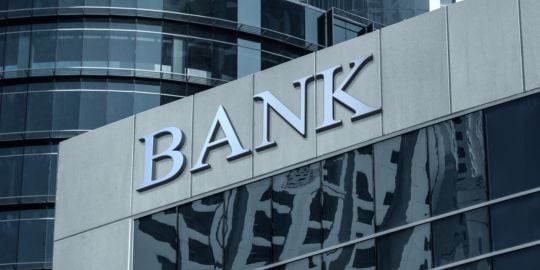Kuwait / Kuwait City
Kuwait City, the capital of the Emirate of Kuwait, has seen the excesses of both wealth and war in recent years. Despite its chequered history, however, it is one of the most vibrant, attractive cities in an otherwise conservative Middle Eastern region.
The Liberation Tower
The symbol of Kuwaiti liberation, the unmistakable sign of the country's resurgence, the Liberation Tower is one of the tallest telecommunications towers in the world.
HH the Amir, Sheikh Jaber Al-Ahmad Al-Jaber Al-Sabah, inaugurated this telecommunications tower in Kuwait City on March 10, 1996. This 372-metre structure is about 40 meters taller than the Eiffel Tower. It was named after the multinational coalition that liberated the nation from seven months of Iraqi occupation during the Gulf War. The tower has now become a symbol of resurgent Kuwait. The structure uses ceramic tiles on the facade from the base to the first mezzanine level, which is about 308 meters above the ground. Three light natural shades provide a geometric design from the base. The tower and the telecommunications complex is divided into three working areas: a public communications center; the revolving observation level and restaurant at 150 meters; and the adjacent plant and equipment structure. There are 18 elevators, two of which are glass enclosed and can accommodate 21 passengers each. They are also among the fastest in the world at 6.3 meters per second. Above the revolving mezzanine, six floors of offices with a total floor space of 12,000 sq m rise up and out in a section encased in anodized aluminum, designed to withstand Kuwait's extreme temperatures.
Kuwait Towers
One of Kuwait's most famous landmarks, the Kuwait Towers are situated on Arabian Gulf Street on a promontory to the east of the City center in Dasman. The uppermost sphere of the largest tower (which is 187 meters high) has a revolving observation area and a restaurant with access by high speed lifts. The entrance fee is 350 fils per person, or free if lunch or dinner has been reserved. Cameras with zoom lens are forbidden. The middle tower contains 1 million gallons of water.
National Museum
Located near the National Assembly, the National Museum comprises four buildings and a planetarium. Stripped and burnt by the Iraqi invaders, it houses the Al-Sabah collection of Islamic art, one of the most comprehensive collections in the world. Iraq has today returned over 90 per cent of the collection. Other buildings housed pearl-diving relics, ethnographic artifacts and archaeological material from excavations on Failaka Island. There are plans to refurbish the old American Hospital building nearby so that some items can be displayed again. The museum also houses the Dar Al-Athar Al-Islamiyyah (DAI), an extensive collection of Islamic art, ranging from early Islam to the 18th century. A variety of scholarly and artistic activities revolve around this collection, each requiring a broad and intensive background in Islamic history. The collection itself is organized according to both historical period and geographical region. To give viewers a comprehensive look at the artifacts, the reference library and the various publications of the Hadeeth ad-Dar (the journal associated with the collection) maintain a close conjunction with the DAI.
Failaka Island
Soldiers are the only permanent residents on this beautiful island left devastated by the Gulf War. It is still worth making the effort to view what is left on the ruins from settlements of the Bronze Age Dilmuns and Hellenistic Greeks, who left many treasures from which their past could be reconstructed. The museum, however, was destroyed, and only a few broken shards of pottery are left.
The home of Kuwait's main archaeological site, Failaka is definitely worth a visit, though it requires a bit of extra caution. The Iraqis turned Failaka into a heavily fortified base and filled the area with mines.
Failaka's history goes back to the Bronze Age Dilmun civilisation, which was centred in Bahrain. The Greeks arrived in the 4th century BC in the form of a garrison sent by Nearchus, one of Alexander the Great's admirals. A small settlement existed on the island prior to this, but it was as the Greek town of Ikaros that the settlement became a real city. The Greeks lived on Failaka for two centuries. The centrepiece of the island is its temple.
Failaka is about 20km (12mi) north-east of Kuwait City's centre and is twelve kilometers long, six kilometers wide, and very flat. The island is well served by ferries, which depart daily from Arabian Gulf St just south of the city centre
Mosques
The pyramid-shaped mosque in Ras Salmiya and the Fatima Mosque in Abdullah Al-Salem are fine examples of modern architecture. The Grand Mosque, opposite the Seif Palace, is an example of several traditional Islamic styles using modern technology while retaining the local characteristics of Kuwait as well as preserving the Islamic tradition of calligraphy. There are several examples of mosques dating from the last century still in use around Kuwait City.
Amusement Parks and Resorts
The government's success in moulding the harsh desert environment of Kuwait can be seen in public parks as also along the sides on many main roads and boulevards. Many of the parks have amusement centers and children's play facilities. There are also several amusement parks dedicated to keeping children actively enthralled for hours at a time.
Recreational Parks
The Kuwait Touristic Enterprises Company (KTEC) manages three recreational parks: at Shaab, Sabahiya and Jleeb Al-Shyoukh. Each park features rides and amusement activities
Entertainment City
Badly damaged during the occupation when many of its facilities were looted and taken to Baghdad, Al-Madina Al-Tarfihiya (the City of Entertainment) is back in business. Run by KTEC and located 20 km from Kuwait City near Doha on the north side of Kuwait Bay, the complex provides a complete range of amusements based on themes from the ‘Arab World', the ‘International World' and the ‘Future World'. It is considered one of the best amusement parks in the world.
Resorts and Chalets
Chalets and other weekend accommodation can be rented in many places along the southern part of the coast. Khiran Resort is a KTEC facility with several hundred chalets and studio flats, a yacht club and a 240-berth fully serviced marina, swimming pools, playgrounds, sports and health facilities, shops, a supermarket and coffee shops.
Sea Clubs
Many of Kuwait's sea clubs offer a wide variety of facilities and activities such as indoor and outdoor swimming pools, beaches, tennis courts, gymnasiums, bowling and even karate. Five sea clubs — Ras Al-Ardh, B'neid Al-Gar, Bida, Shaab and Fahaheel — are run by the KTEC. Each club has a special day or time for women and children only; Ras Al-Ardh is reserved exclusively for women and children. The Kuwait Sea Sports Club is government-owned and has facilities for all major sea sports. There are also several private sea clubs.
Bayt Al-Badr
An old house located next to Al-Sadu house, Bayt Al-Badr was built between 1838 and 1848. It possesses a fine example of the famous front doors of old Kuwait. Local handicrafts are sometimes displayed here.
Science and Natural History Museum
The museum contains displays relating to the petroleum industry, natural history, aviation, machinery, electronics, space and zoology, as well as a health hall and a planetarium. Much of the Science and Natural History Museum has been restored since Liberation.
Liberation Monument
The site of a bloody battle between the Kuwaitis and the Iraqis just before Liberation, Al-Qurain House is now a museum dedicated to those who laid their lives. It is situated in the new Qurain housing area. A mounted Iraqi tank at the Jahra Gate roundabout at the end of Fahd Al-Salem Street is a reminder of the folly of war. Another such monument, next to the main entrance of the Ministry of Information in Soor Street, has a walkthrough pictorial display of scenes from the Iraqi occupation and is well worth a visit. There are several other such monuments around the City and the country.
Municipal Gardens
The Municipality maintains several public gardens around the country. One of the most popular is in Fahd Al-Salem Street. All the gardens are well designed with naturally shaded areas.
Zoological Park
Located in Omarrya on the Airport Road, the Kuwait Zoo covers 180,000 sq meters of parkland. Very few of the zoo's animals survived the Iraqi occupation but through a dedicated reconstruction program the zoo reopened in February 1993. Today it houses 65 species of animals, 129 species of birds and five species of reptiles, apart from other animals such as lions, tigers, elephants, giraffes, zebras, etc.
Musical Fountain
Located near the Ice Skating Rink on the 1st Ring Road, and badly damaged during the Occupation but now fully refurbished, the Musical Fountain provides a unique and delightful sight and sound show of musical fountains.
Seashell Resort
Situated on the white sand beaches of Julai'a, Seashell 5 Star Hotel and Resort enchanting Mediterranean style villas and chalets embody the spirit of luxury, serenity and enjoyment.
With its amazing lavish residences, beach front chalets, dining restaurants and cafes, conference rooms, sea front, swimming pools and fountains; guests of Sea Shell enjoy world-class services and endless opportunities of leisure and entertainment.
To relax and rejuvenate, for a short or long vacation, for a business meeting or conference, for a truly romantic honeymoon or to celebrate special occasion…; Sea Shell Julaia Hotel and Resort is the place for you like no other.
Movenpick Resort (Free Zone)
Discover one of the very best hotels in the city: the Mövenpick Hotel Kuwait, where you can relax in capable hands. Unique architectural elegance awaits you, exclusive recreation facilities indulge you and the treat of passionately Swiss hospitality makes you feel at home.
The Mövenpick Hotel Kuwait is situated on Shuwaikh Bay in the heart of Kuwait Free Trade Zone. The hotel is just a 10-minute drive from Kuwait International airport, 6 minutes from Kuwait City and 4 minutes from Shuwaikh Industrial Area.
The Avenues Mall
A great shopping center, dining area and the following entertainment areas,
Cinescape
Magic Planet
Color Me Mine
Baroue Entertainment Center
or if you dont like any of the above, go to a private party (which are usually held in private chalets or apartments) and are illegal by the way, you'll get to dance, drink alcohol, play poker, and do almost anything you want, its unlikely to get caught in a party, but its illegal anyway so i dont recommend foreigners do it.
Places to visit in Kuwait
Welcome to Expat.com xcurse!
Thanks for these useful tips.
Harmonie.
Thanks for the information. Very helpful indeed.
OMG
Subscribe to this topic

Open a bank account that suits you
Discover the best international banks to manage your money securely.
"








